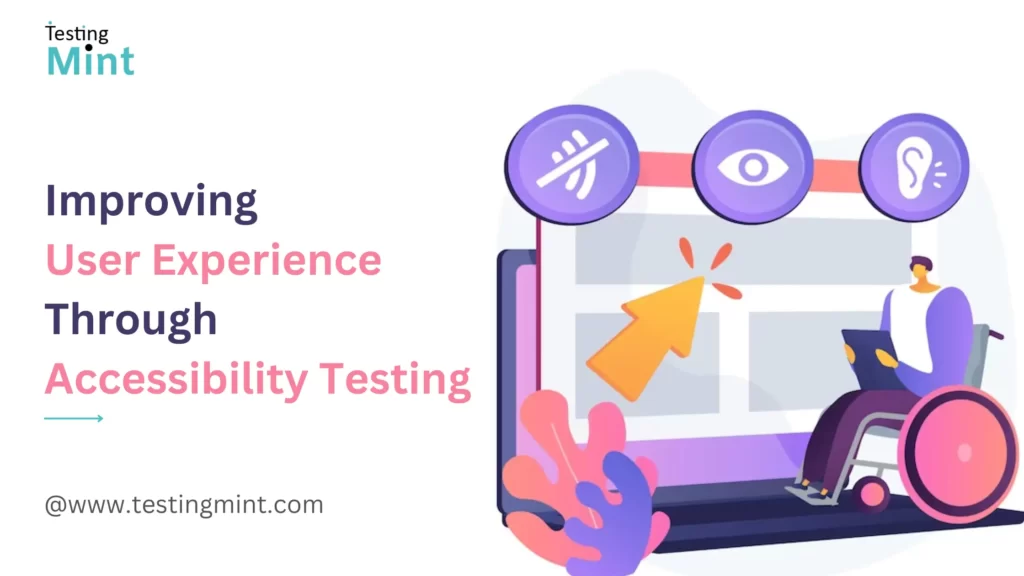As the world becomes more digital, there is a need to ensure that technology is accessible to everyone, regardless of their abilities. Accessibility testing plays a critical role in achieving this goal by identifying any barriers that may prevent people with disabilities from using software and applications. In this blog, you’ll learn more about the importance of accessibility testing and how it can improve the user experience for everyone. Let’s get started!
What is Accessibility Testing?
Accessibility testing involves checking a software application or website to see if it can be used easily by people with disabilities. This includes checking whether the user interface is easy to navigate and the text is legible and whether the application can be used with assistive devices such as screen readers. The goal of accessibility testing is to ensure that everyone, regardless of ability, can use the technology without barriers. In other words, it’s about making sure that the technology is accessible and usable for everyone.
Importance of Accessibility Testing
Accessibility testing is important because it helps create a more inclusive world where everyone can use technology without barriers. Here are some reasons why accessibility testing is so important:
- Improved User Experience:
accessibility testing allows you to identify and fix any issues that may prevent people with disabilities from using your software or website. This leads to a better user experience for everyone. - Compliance with Regulations:
In many countries, accessibility is required by law. By conducting accessibility testing, you can ensure that your software or website complies with regulations and avoid potential legal issues. - Increased Reach:
Making your software or website accessible can help you reach a wider audience, including people with disabilities who may have been previously excluded. - Better Brand Reputation:
Providing an accessible user experience can help to improve your brand reputation and show that you care about inclusivity and diversity. - Improved User Satisfaction:
When users can use your software or website without encountering any barriers, they are more likely to be satisfied with your product. This can lead to increased customer loyalty and positive word-of-mouth recommendations. - Improved Accessibility for All:
Accessibility testing not only benefits individuals with disabilities, but it can also improve the user experience for everyone, including older adults and people with temporary disabilities. For example, testing for high contrast and large text can make your website easier to read for everyone, not just individuals with visual impairments.
Types of Disabilities
Accessibility testing is essential in making sure that technology is used for individuals with various types of disabilities. Here are some of the common types of disabilities that accessibility testing addresses:
- Visual Impairments
Visual impairments can make it difficult for individuals to go about their daily lives and perform various tasks, including using technology. There are many types of visual impairments, such as low vision, color blindness, and blindness, and each type can affect an individual differently, but accessibility testing can help to address these issues.
Here are some of the ways that accessibility testing can help individuals with visual impairments:- High Contrast:
Accessibility testing for high contrast ensures that the text and images on the website or software have enough contrast to be easily readable for individuals with low vision. - Large Text:
Accessibility testing for large text ensures that individuals with visual impairments can increase the size of the text on the website or software to make it easier to read. - Alt Text:
Accessibility testing for alt text ensures that individuals using screen readers can understand the content of images on the website or software. - Zoom Functionality:
Accessibility testing for zoom functionality ensures that individuals with visual impairments can zoom in on the website or software to make it easier to read. - Color Blindness:
Accessibility testing for color blindness ensures that individuals with color blindness can use the website or software without difficulty.
- High Contrast:
- Auditory Impairments
Auditory impairments can make it difficult for individuals to access and understand audio information, including information presented through technology. There are many types of auditory impairments, such as deafness and hard of hearing, and each type can affect an individual differently.
Here are some of the ways that accessibility testing can help individuals with auditory impairments:- Closed Captions:
Accessibility testing for closed captions ensures that individuals with auditory impairments can access audio information through written captions. - Audio Descriptions:
Accessibility testing for audio descriptions ensures that individuals with auditory impairments can access information about the visual elements in videos and multimedia content. - Volume Control:
Accessibility testing for volume control ensures that individuals with auditory impairments can adjust the volume of audio information to their preferred level. - Audio Transcripts:
Accessibility testing for audio transcripts ensures that individuals with auditory impairments can access written transcripts of audio information.
- Closed Captions:
- Motor Impairments
Motor impairments can make it difficult for individuals to interact with technology, especially if the technology is designed without accessibility in mind. There are many types of motor impairments, such as limited dexterity, tremors, and paralysis, and each type can affect an individual differently.
Here are some of the ways that accessibility testing can help individuals with motor impairments:- Keyboard Navigation:
Accessibility testing for keyboard navigation ensures that individuals with motor impairments can use the website or software without the need for a mouse. - Voice Control:
Accessibility testing for voice control ensures that individuals with motor impairments can use voice commands to interact with the website or software. - Touchscreen Navigation:
Accessibility testing for touchscreen navigation ensures that individuals with motor impairments can use the website or software through touch gestures. - Customizable Buttons:
Accessibility testing for customizable buttons ensures that individuals with motor impairments can customize buttons and other controls to meet their needs.
- Keyboard Navigation:
- Cognitive Impairments
Cognitive impairments can make it difficult for individuals to process and understand information, including information presented through technology. There are many types of cognitive impairments, such as dyslexia, ADHD, and dementia, and each type can affect an individual differently.
For individuals with cognitive impairments, accessibility testing can help to make sure that technology is usable. Here are some of the ways that accessibility testing can help individuals with cognitive impairments:- Simplified Language:
Accessibility testing for simplified language ensures that individuals with cognitive impairments can understand the content presented through the website or software. - Consistent Navigation:
Accessibility testing for consistent navigation ensures that individuals with cognitive impairments can find what they’re looking for with ease and that the website or software is easy to use. - Clear Visual Hierarchy:
Accessibility testing for clear visual hierarchy ensures that individuals with cognitive impairments can understand the content presented through the website or software. - High Contrast Colors:
Accessibility testing for high-contrast colors ensures that individuals with cognitive impairments can see the content presented through the website or software more easily.
- Simplified Language:
- Speech Impairments
Speech impairments can make it difficult for individuals to communicate, including through technology. There are many types of speech impairments, such as stuttering, dysarthria, and apraxia, and each type can affect an individual differently.
Here are some of the ways that accessibility testing can help individuals with speech impairments:- Text-to-Speech:
Accessibility testing for text-to-speech ensures that individuals with speech impairments can have the content presented through the website or software read aloud to them. - Speech Recognition:
Accessibility testing for speech recognition ensures that individuals with speech impairments can interact with the website or software through speech commands. - Closed Captions:
Accessibility testing for closed captions ensures that individuals with speech impairments can understand the content presented through audio on the website or software. - Audio Descriptions:
Accessibility testing for audio descriptions ensures that individuals with speech impairments can understand the content presented through video on the website or software.
- Text-to-Speech:
Accessibility Testing Techniques
There are several techniques that can be used to test the accessibility of websites, applications, and other technology products.
- Manual Testing:
This technique involves manually testing the accessibility of the technology using a keyboard and other assistive technologies, such as screen readers. This technique can be time-consuming, but it provides a detailed understanding of the accessibility of the technology. - Automated Testing:
This technique involves using automated tools, such as accessibility checkers and screen reader simulators, to test the accessibility of the technology. Automated testing is a fast and efficient way to test the accessibility of technology, but it may not always provide a comprehensive understanding of the accessibility of the technology. - User Testing:
This technique involves testing the accessibility of the technology with real users with disabilities. User testing can provide valuable insights into the real-world accessibility of the technology, but it can be time-consuming and difficult to arrange. - Code Review:
This technique involves reviewing the code of the technology to ensure that it meets accessibility standards and guidelines. Code review can be a fast and efficient way to test the accessibility of the technology, but it may not always provide a comprehensive understanding of the accessibility of the technology.
Accessibility Testing Tools
Here are some of the Tools used in Accessibility Testing:
- WAVE:
WAVE is a free web accessibility evaluation tool developed by WebAIM. It allows you to easily check your web page for accessibility issues and provides detailed information on how to fix them. - NVDA:
NVDA (NonVisual Desktop Access) is a free screen reader for Windows computers. It allows you to navigate your computer and applications using only keyboard commands, making it an essential tool for accessibility testing. - VoiceOver:
VoiceOver is the built-in screen reader for Mac computers. It provides spoken and Braille feedback, making it a great tool for testing the accessibility of your website or application on Mac devices. - Accessibility Checker for Microsoft Office:
This tool is built into Microsoft Office and allows you to check the accessibility of your documents and presentations for people with disabilities. - JAWS:
JAWS (Job Access With Speech) is a popular screen reader for Windows computers. It provides a range of features to help users with disabilities access their computers and the web. - aXe:
aXe is a JavaScript library that allows you to test the accessibility of your web pages. It provides detailed information on accessibility issues and suggestions on how to fix them. - Color Contrast Analyzer:
The Color Contrast Analyzer is a tool that helps you determine if the colors used on your web page provide enough contrast to be easily read by people with color blindness or other visual impairments. - Accessibility Insights for Windows:
Accessibility Insights for Windows is a tool developed by Microsoft that provides a comprehensive accessibility testing solution for Windows applications. - Lighthouse:
Lighthouse is an open-source tool developed by Google that provides automated accessibility testing for web pages. It provides detailed information on accessibility issues and suggestions on how to fix them.
In conclusion, accessibility testing plays a critical role in improving usability and ensuring that your website or application is accessible to everyone, including people with disabilities. By conducting accessibility testing on a regular basis, you can identify and remove any barriers that may prevent users from accessing your website or application.
In addition, accessibility testing is not just about the legal compliance or moral obligations; it also makes good business sense. A website or application that is accessible to all can expand your user base, increase customer satisfaction, and strengthen your brand’s reputation.
Therefore, accessibility testing should be an integral part of your development process, not just an afterthought. By prioritizing accessibility, you can create a better user experience for everyone and build a more inclusive digital world.

